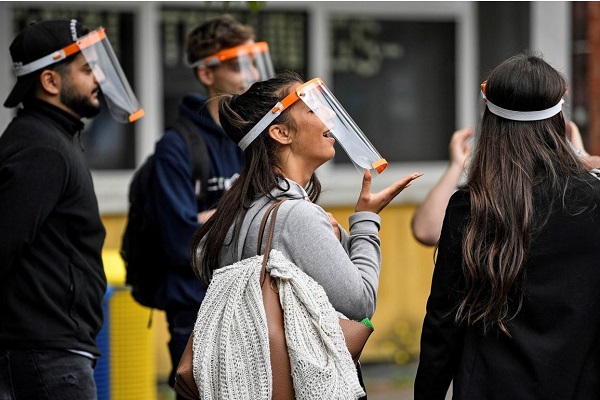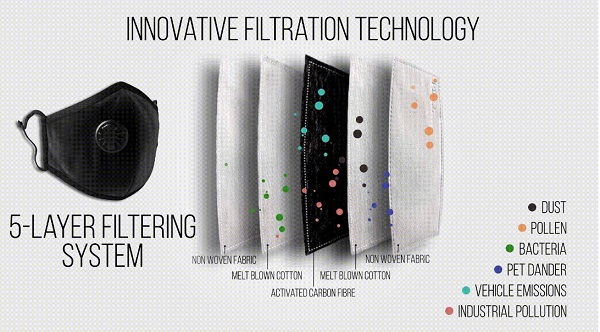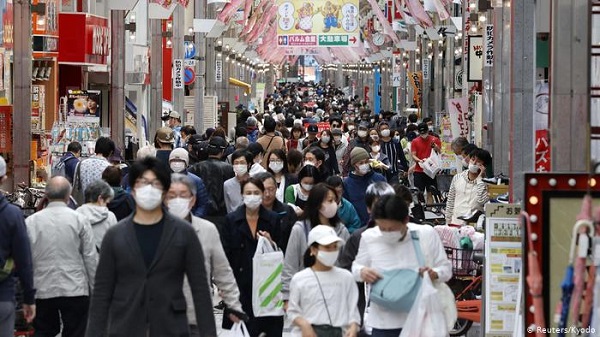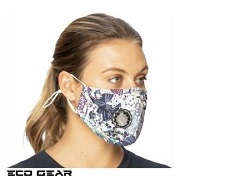During the whole coronavirus period it has seemed to me that Australia has a world class expert on the topic behind every tree. One who stood out to me was Professor Raina MacIntyre, Head of the Biosecurity Program at the Kirby Institute and NHMRC Principal Research Fellow, UNSW. She seemed to tell it like it is, had an appropriate sense of the precautionary principle, and was not on any panel advising politicians. It is well-known that experts advising politicians often end up tayloring their advice to what the pollies want to do.

In Australia the common advice from the authorities is for the plebs to restrict wearing masks to those who have the virus.
To cut to the chase, MacIntyre says she wears a mask whenever she steps outside her home, and wears one inside when anyone comes to visit.
She concedes that it would be appropriate and super-precautionary to wear one inside the home as well.
To me the logic is simple. If people who have the virus should wear a mask, then the precautionary principle demands that everyone is deemed to have the virus, and be able to spread it, whether they know it or not while asymptomatic or pre-symptomatic..
The argument against this assertion is that you can do yourself some damage by wearing a mask and misusing it, or handling it incorrectly before disposal. MacIntyre says that the benefits of wearing a mask are such that it would pay to inform and educate people.
Consider this. MacIntyre says that, as best we know, around 15% of people with the virus are asymptomatic. They never show a symptom.
And get this – one study shows that 44% of transmission occurs in the two days before when symptoms show, which happens to coincide when virus sufferers are most infectious.
Dr Norman Swan interviewed MacIntyre about the new research just published in The Lancet on ABC RN in Face masks, physical distancing drastically reduce coronavirus risk (transcript available). The Lancet published the research with an introductory commentary by MacIntyre, which gives some idea of her standing within the profession. Here are the links:
- Kirby Institute media release 2 June, 2020 – COVID-19: by how much do social distancing and masks reduce the risk?
- D. K. Chu et al – Physical distancing, face masks, and eye protection to prevent person-to-person transmission of SARS-CoV-2 and COVID-19: a systematic review and meta-analysis
The study was commissioned by the WHO. Dr Chu is from Stanford University. He used a multi-national team well-practiced in data analysis.
MacIntyre from her Lancet commentary says the findings show:
- a reduction in risk of 82% with a physical distance of 1 m in both health-care and community settings … Every additional 1 m of separation more than doubled the relative protection, with data available up to 3 m …
- While N95 respirators reduced the risk of infection by 96%, masks were 67% effective.
- For health workers eye protection resulted in a 78% reduction in infection.
I gather that for eyes transmission can either be by aerosol or self-infection after touching surfaces.
MacIntyre says the coronaviruses are much more airborne than other respiratory diseases. For scary stuff about airborne coronavirus, see, for example, COVID 19 can spread through breathing, talking, study estimates and from National Geographic See how a sneeze can launch germs much farther than 6 feet, indeed as far as eight metres. The literature seems concerned with “droplet sprays” of virus-laden respiratory tract fluid, typically greater than 5 μm in diameter, or alternatively, microscopic aerosol particles tiny enough (<5 μm) to remain airborne for hours. Lydia Bourouiba at MIT used high-speed cameras to chart the spread of human pathogens:
-
Slowed to 2,000 frames per second, video and images from her lab show that a fine mist of mucus and saliva can burst from a person’s mouth at nearly a hundred miles an hour and travel as far as 27 feet. When the sternutation is over, a turbulent cloud of droplet-containing gas can remain suspended for several minutes, depending on the size of the droplet.
The main problem is that we don’t know how big a load of the virus is needed to create infection, and more work needs to be done on the design of masks. Norman Swan spoke of:
- the WHO also recommended the criterion for an effective home-made mask, I think it was triple-layered with an absorbent material on the inside such as closely woven cotton, and on the outside a polypropylene that was waterproof.
The New Daily has a handy article on masks, with lots of information in Face masks are no silver bullet for coronavirus – but they do have benefits.
The date was 30 May, just before the Lancet article saw the light of day, and just after Australian Government’s Infection Control Expert Group had published their report taking the general line:
- “In Australia, the routine use of masks in the community is currently not recommended, while the rate of community transmission of COVID-19 is low.”
They take the use of masks and respirators very seriously indeed, but after a lengthy review of the literature end up saying:
- that airborne transmission of COVID-19 is infrequent and the routine use of airborne precautions not warranted.
Sorry, I’m scratching my balding head at this point. If this is the case, why have distancing? Earlier (page 3) they had said this:
- Current evidence suggests that most respiratory viral infections are principally spread by droplets, directly or indirectly, between individuals in close proximity to each other. Modelling studies indicate that the risk of infection from small particles is many times less than from droplets or self-inoculation by contaminated hands.
They seem to be taking out of play aerosol clouds. (In their analysis the dividing line between droplets and aerosol particles is 10 microns.)
The Chu meta-study analysed real life studies, not modelling. Furthermore it showed that masks did real work in preventing infection, but not all masks. Single layer masks were close to useless.
I would reason that single layer masks would stop droplets, so the fine aerosols must be getting through them, but not so much through the multi-layer masks.
The Australian expert group cited copious research to back their view. I think the difference may lie in the methodology used by the Chu team, which is summarised at the beginning of their paper. They cast the net very wide, drawing in research from 16 countries with no language barrier. However, they then applied quite rigorous criteria to identify the usable studies.
That being said, there is very little chance of the Australian official view changing. MacIntyre said that the issue of masks had been problematic for over a decade, and subject to what she called “politics”. When asked by Norman Swan what she meant by that, she said:
- The debate and discussion around the use of masks is not driven by evidence, it’s driven by other issues, ideology and beliefs and issues that have not got anything to do with the scientific evidence, that’s all I can say.
MacIntyre also talked to Norman Swan about research that she was involved in – see Face masks, physical distancing and disinfection reduces household transmission of COVID-19, new research finds. She says that the majority of COVID-19 infections are acquired inside the family home, so the researchers looked at families where there had been an initial infection, then compared families which had additional cases of infection to those that did not, to see which factors were most protective. In summary:
- researchers found that face masks were 79% effective and daily household disinfection was 77% effective in preventing transmission, whilst close frequent contact (such as sitting in close proximity at meals or while watching television) increased the risk of transmission 18 times.
However, face masks were effective:
- only if used prior to the onset of symptoms. Wearing a mask only after symptoms start did not protect. The research provides real-world evidence that supports virological studies that suggest SARS-CoV-2 is most infectious in the two days before symptoms start.
Obviously this is important for families where a health worker is working in the front line.
The US Centre for Disease Control highlights asymptomatic and pre-symptomatic transmission, and recommends:
- wearing cloth face coverings in public settings where other social distancing measures are difficult to maintain (e.g., grocery stores and pharmacies) especially in areas of significant community-based transmission.
They even give detailed instructions on how to make a two-layer mask yourself.
The WHO’s latest advice is downloadable from here. It cites the Chu study (see page 6), but it’s like they didn’t read it carefully. They say it:
- showed that either disposable surgical masks or reusable 12–16-layer cotton masks were associated with protection of healthy individuals within households and among contacts of cases.
However, they say:
- individuals would need to be in close proximity to an infected person in a household or at a mass gathering where physical distancing cannot be achieved, to become infected with the virus.
So just stay separated, and if you cough or sneeze, just do it into your elbow or a tissue.
MacIntyre says the point is that you can’t control what happens around and to you, especially in crowded places. She also says that the point is to use all precautionary measures, not one instead of the other.
The WHO do say that asymptomatic people are less infectious than those who have or develop symptoms, but they still can be infectious.
MacIntyre says that Australia’s official position is reasonable while community infection is low, but she says we can’t live in a silo forever. As the world opens up we will still be vulnerable. Right now we have Singapore in discussions with S. Korea, Australia, to establish ‘green lanes’ for travel. In Singapore you can be fined for not wearing a mask in public.
It is interesting therefore that Thais Score Highest in Survey for Mask-Wearing and Singaporeans score lowest of six Asian countries:
- According to a YouGov survey, 95 percent of Thais constantly wear face masks in public, followed closely by Vietnam (94 percent), Philippines (93 percent), Malaysia (89 percent), and Indonesia (87 percent) – leaving behind Singapore (66 percent).
The article also says:
- Across all six Asian nations surveyed, 86 percent said they always or frequently wore face masks when exiting the house – compared to a 15 percent response in the UK, 44 percent in France, and 48 percent in the US.
In Germany students are being given face shields which may be a useful alternative:

It seems that In the US face masks are becoming part of the political/culture wars, and may indicate how you vote. The article links to a study by Zang et al Identifying airborne transmission as the dominant route for the spread of COVID-19, which is quite direct in its advice:
- We conclude that wearing of face masks in public corresponds to the most effective means to prevent interhuman transmission, and this inexpensive practice, in conjunction with simultaneous social distancing, quarantine, and contact tracing, represents the most likely fighting opportunity to stop the COVID-19 pandemic.
This study, published 11 June, 2020 was unsurprisingly not cited by the Australian Expert Group, nor by WHO.
MacIntyre said that, current efforts to find a vaccine notwithstanding, she thinks the virus could be with us for up to another five years.
Back in March we decided to order online masks from Bondi Air:

Great Aussie brand, you might think, but yes, made in China. It’s $39.95 for the re-usable mask with which you get two five-layer filters which fit in an inner sleeve. A 10-pack of extra filters costs $19.95.
They said the masks would come next week. In the event I think our masks went to Italy, which I did not begrudge them. We got ours around the third week in April.
You have to suck a bit to get air through the vent. I think that is how it is supposed to work. However, when you breathe out the place of least resistance is the edge, so you breath comes out on your face, and can fog you glasses.
The mask itself is washable; they recommend changing the filter after 40 hours of use.
Sites like NSW Health give advice on using masks. We need more of that.
The Guardian also offers practical advice on face masks, and how to make them if that is your wish.
Last Friday I ventured into JB HiFi at Indooroopilly Shopping Centre on an emergency errand. The shopping centre was doing very well, as was JB HiFi. Apart from myself, I saw only one man (ethnically Asian) wearing a mask. Other than the Covid conforming configuration of coffee shop seating, not much else was different from pre-virus days. I think at some time in the future we may see more masks, and if we did, our virus consciousness would improve.
Then we could maybe get around like this:



This was meant to be a simple 500 word post on the interview by Norman Swan and Raina MacIntyre, and was meant to be finished last Wednesday.
It got a bit out of control again, but I thought it worthwhile to run up a few rabbit borrows.
This is in line with what I have seen in places like New Scientist.
Australia had to start with a limited number of actions such as lock down, state border closures and social distance rules. Problem is that relying on these strategies killed a lot of jobs and shrank the economy.
Part of the problem was that too much seemed to be going through the federal cabinet which meant that not enough effort was going into doing things like looking at what the very successful countries were doing, particularly those that were getting results without tanking their economies.
My take on the successful countries was that they were prepared and used multiple strategies in parallel to both help get good results and minimize economic disruption. Strategic use of masks, hand washes and temperature checks in addition to some social distancing seems seems to have allowed Taiwan to get better results than Aus with much much less economic damage.
Problem with Morrison is that he is a kacky handed manager with control freak tendencies.
What we needed then and now was task forces looking for less damaging strategies.
John, somebody said that lock-downs were for countries that were not ready and had lost control. Essentially that is what happened to us. Faffing around for six weeks, skiting about how many tests we were doing, when at the time you had to have two indicators (having contact with a person with the disease, plus at least one symptom, which now would be seen as hopelessly inadequate) before a test would be considered.
We only look good now because others look a whole lot worse.
John, you wrote
“My take on the successful countries was that they were prepared….”
Maybe that was the nub of it.
Be better prepared.
(As an unhelpful analogy, populated parts of this continent are relatively well prepared to reduce deaths in bushfires. Many fewer died last summer than on Black Saturday, 2009.)
Brian: “somebody said that lock-downs were for countries that were not ready and had lost control. Essentially that is what happened to us. ” Yep. And, under those circumstances our governments were right to start with lockdowns, distance rules and travel restrictions spacing because they did not require resources. Problem is that these actions damage the economy and our governments became addicted to these brute force approach and appeared to do nothing to get work started on less damaging alternatives.
Good senior management under these circumstances can involve senior management stepping back and looking at the bigger picture and/or maintaining their control over the short term action and setting up high powered groups tasked with looking for less damaging alternatives and what other successful countries were doing.
Using Taiwan as a starting point we should have been looking at things like face covering, more hand cleaning stations, temperature checking and fact based distance rules.
Some task forces should also have been looking at what needed to be done to get businesses that were being damaged by the rules back closer to normal business. They might have looked at things like various types of face, eyes and hand covering, creating jobs aimed at keeping surfaces that people touch cleaner. They might of looked at ways of killing airborne virus, reducing air recirculation, directing airflows or the use of partitions between tables to reduce the risk of contaminated air reaching people.
Then there are other things like using one way aisles in supermarkets and……. (Suggestions pls.)
Brilliant, John. Certainly I think the Taiwan approach was the most complete and the most sophisticated. And you are right, our thinking has been stuck in a rut.
Have to go to bed now, but yes, suggestions welcome.
At the supermarket we use, one way aisles were instituted only in a couple of narrower aisles (the others being comfortably wide).
We also had an “oldies only” hour 8am to 9am at that supermarket in the first few weeks.
Air flow is scarcely considered and warrants more study and design work. In close quarters (passenger planes? Trains, buses, trams) it’s tricky.
BTW I doubt we’ll have economical ultraviolet virus-zappers in air ducts soon.
But what would I know? I recall in the early 1960s the fuss about red laser light beams being very dangerous. Now they issue checkout lads with tiny laser barcode readers and put tiny lasers inside CD players. Unimaginable. Ridiculous. (A bit of reminiscence “fluff” for Young Jumpy)
In recent times I’ve been to an optometrist, a GP and a physiotherapist, none of whom were wearing masks. Given the number of people they see each day, that surprised me.
Also checkout persons.
Some establishments have installed a glass shield at the counter, some haven’t. I think we could do better.
Brian: We seem to be responding to the reduction in cases by stepping back from what we did at the start. The risk here is that, if we have a second wave we will simply reimpose the brute force stuff. (I also get the feel that many decisions both ways have political rather than decisions based on good science and/or good management decisions. I would have been more impressed if the winding back of the damaging policies had been accompanied by less damaging stuff like wearing masks.)
Having a kacky handed manager he tends towards being a control freak doesn’t help.
Right now we should be setting up the expert committees or whatever tasked with providing advice that might help safely returning to normal faster.
Ditto the expert committees tasked with preparing a professional plan for handling the next crisis.
Not holding my breath in both cases.
Another article recommending the use of face masks People are getting sick from coronavirus spreading through the air – and that’s a big challenge for reopening from Douglas Reed, Associate Professor of Immunology, University of Pittsburgh, with really specific information about droplets and aerosols, plus a lot of links.